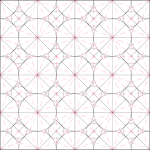- Napkin folding problem
-
The napkin folding problem in geometry explores whether folding a square or a rectangular napkin can increase its perimeter. The problem is known under several names, including the Margulis napkin problem, suggesting it is due to Grigory Margulis, and the Arnold's rouble problem referring to Vladimir Arnold and the folding of a Russian ruble. Some versions of the problem were solved by Robert J. Lang, Svetlana Krat, Alexey S. Tarasov, and Ivan Yaschenko. One form of the problem remains open.
Contents
Formulations
There are several way to define the notion of folding, giving different interpretations. By convention, the napkin is always a unit square.
Folding along a straight line
One can consider sequential folding of all layers along a line. In this case it can be shown that the perimeter is always non-increasing under such foldings, thus never exceeding 4.[1][2]
It is still unknown if there is a solution using a sequence of foldings, such that each is a reflection of a connected component of folded napkin on one side of a straight line.[3] That is whether a solution can be folded using some combination of mountain folds, valley folds, reverse folds, and/or sink folds (with all folds in the latter two cases being formed along a single line). Also unknown, of course, is whether such a fold would be possible using the more-restrictive pureland origami.
Where only the result matters
One can ask whether there exists a folded planar napkin (without regard as to how it was folded into that shape).
Robert J. Lang showed in 1997[2] that several classical origami constructions give rise to an easy solution.[4] In fact, Lang showed that the perimeter can be made as large as desired by making the construction more complicated. However his constructions are not rigid origami because of their use of sink folds and related forms; although no stretching is needed in sink and unsink folds, it is necessary to curve facets and/or sweep one or more creases continuously through the paper in intermediate steps before obtaining a flat result.
In 1998, I. Yaschenko constructed a 3D folding with projection onto a plane which has a bigger perimeter.[5] This indicated to mathematicians that there was probably a flat folded solution to the problem.
The same conclusion was made by Svetlana Krat.[6] Her approach is different, she gives very simple construction of a "rumpling" which increase perimeter and then proves that any "rumpling" can be arbitrary well approximated by a "folding". In essence she shows that the precise details of the how to do the folds don't matter much if stretching is allowed in intermediate steps.
Folding without stretching
One can ask for a realizable construction within the constraints of rigid origami where the napkin is never stretched whilst being folded. In 2004 A. Tarasov showed that that such constructions can indeed be obtained. This can be considered a complete solution to the original problem.[7]
Solutions
Lang's solutions
Lang devised two different solutions.[4][8] Both involved sinking flaps and so were not rigid origami. The simplest was based on the origami bird base and gave a solution with a perimeter of about 4.12 compared to the original perimeter of 4.
The second solution can be used to make a figure with a perimeter as large as desired. He divides the square into a large number of smaller squares and employs the 'sea urchin' type origami construction described in his 1990 book, Origami Sea Life.[8] The crease pattern shown is the n = 5 case and can be used to produce a flat figure with 25 flaps, one for each of the large circles, and sinking is used to thin them. When very thin the 25 arms will give a 25 pointed star with a small center and a perimeter approaching N2/(N − 1). In the case of N = 5 this is about 6.25, and the total length goes up approximately as N.
History
Arnold states in his book that he formulated the problem in 1956, but the formulation was left intentionally vague.[1][9] He called it 'the rumpled rouble problem', and it was the first of many interesting problems he set at seminars in Moscow over 40 years. In the West, it became known as Margulis napkin problem after Jim Propp's newsgroup posting in 1996.[2] Despite attention, it received folklore status and its origin is often referred as "unknown".[5]
See also
References
- ^ a b Arnold, Vladimir Igorevich (2005). Arnold's Problems. Berlin: Springer. ISBN 3-540-20748-1.
- ^ a b c "The Margulis Napkin Problem, newsgroup discussion of 1996". Geometry Junkyard. http://www.ics.uci.edu/~eppstein/junkyard/napkin.html.
- ^ Petrunin, Anton (2008). "Arnold's problem on paper folding" (in Russian). Zadachi Sankt-peterburgskoj matematicheskoj olimpiady shkol'nikov po matematike. arXiv:1004.0545.
- ^ a b Lang, Robert J. (2003). Origami Design Secrets: Mathematical Methods for an Ancient Art. A K Peters. pp. 315–319.
- ^ a b Yaschenko, I. (1998). "Make your dollar bigger now!!!". Math. Intelligencer 20 (2): 38–40. doi:10.1007/BF03025296.
- ^ S. Krat, Approximation Problems in Length Geometry,Ph.D. thesis, Pennsylvania State University, 2005
- ^ Tarasov, A. S. (2004). "Solution of Arnold's "folded ruble" problem" (in Russian). Chebyshevskii Sbornik 5 (1): 174–187. http://www.tspu.tula.ru/res/math/c_sbor/tom5/v1/15_9.htm.
- ^ a b Montroll, John and Robert J. Lang (1990). Origami Sea Life. Dover Publications. pp. 195–201.
- ^ Tabachnikov, Sergei (2007). "Book review of "Arnold's problems"". Math. Intelligencer 29 (1): 49–52. doi:10.1007/BF02984760. http://www.math.psu.edu/tabachni/prints/Arnoldpr.pdf.
External links
Categories:- Discrete geometry
- Mathematical theorems
- Paper folding
- Recreational mathematics
Wikimedia Foundation. 2010.

